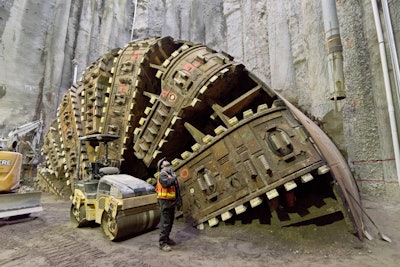 A worker with Seattle Tunnel Partners watches as co-workers are lifted out of Bertha’s repair pit Dec. 15, 2015. With repairs complete, crews filled the hole in in order to begin tunneling with the machine after a 2-year delay. Photo Credit: WSDOT Flickr
A worker with Seattle Tunnel Partners watches as co-workers are lifted out of Bertha’s repair pit Dec. 15, 2015. With repairs complete, crews filled the hole in in order to begin tunneling with the machine after a 2-year delay. Photo Credit: WSDOT FlickrThough the contractor behind the Washington state Highway 99 project said it might give crews a holiday break before resuming the dig, Bertha, the world’s largest tunnel-boring machine, made its first progress in two years deep below Seattle last week.
According to an announcement from the Washington State Department of Transportation, Bertha moved forward 1.5 feet Dec. 22, giving crews enough room to install a portion of tunnel at the bottom of the 120-foot-deep pit built earlier this year to repair the machine.
The machine went down in January 2014, just one-tenth of the way through digging a 1.7-mile tunnel which will replace the Alaskan Way viaduct and carry a double-deck highway beneath Seattle. The project was originally scheduled for completion by the end of this year but has been delayed time and time again by a long list of setbacks.
In April we showed you the process of lifting the massive machine’s cutterhead through a 120-foot deep access tunnel and in September, took you through the process of repairing the massive machine.
In the video below, Chris Dixon, project manager for Seattle Tunnel Partners discusses that repair process in detail before describing how the contractor plans on moving forward with the project.
Dixon told the Seattle Times, that for the next few weeks, the machine will be in a testing phase in order to see how the repaired machine responds to digging through the sand workers recently filled the repair pit with. At the start of the New Year, crews will begin tunneling through the concrete north wall of the pit before pushing forward 450 feet over the course of the next four weeks.









